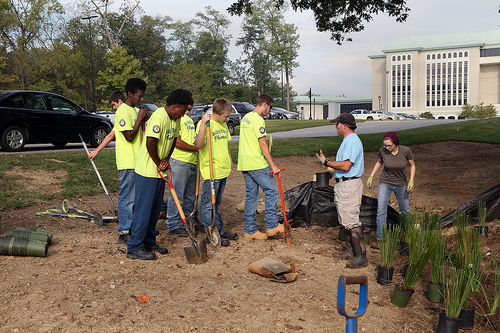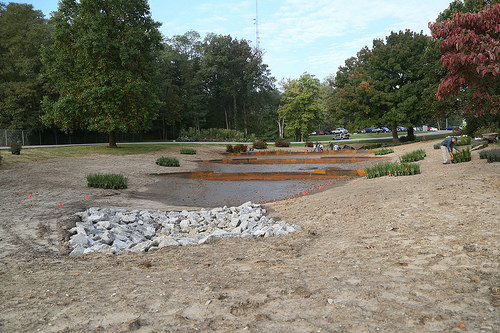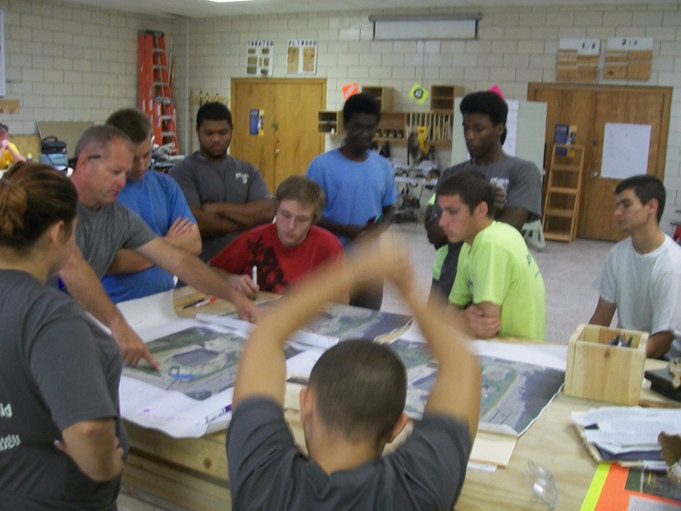
L&C instructor Scott Moss teaches students about sustainable landscaping, while installing a bioswale on L&C’s Godfrey campus.
Hello all, and welcome to another Building Futures YouthBuild AmeriCorps Blog post!
Building Futures continued their AmeriCorps service projects by working in conjunction with the Restoration Ecology and Storm Water Management Program at Lewis and Clark Community College.
For returning readers, that department should ring a bell. For all you newbies to the Building Futures blog, if you don’t know how those programs are affiliated with YouthBuild, don’t feel bad. I’ll catch you up to speed with a brief explanation.
Scott Moss, the coordinator for the Restoration and Ecology Department at Lewis and Clark Community College, assisted Building Futures members in designing a cost efficient, native landscape for local Habitat for Humanity homeowners. Moss drew up property plans that allowed the students to see the natural flow of water to the property. He then taught the students about different storm water management options, and plants that are native to the area.
I know what you’re thinking! What is restoration ecology? I’ll save you from a Google search, because I’m such a sweet and caring guy. Restoration ecologists repair damaged lands, habitat and ecosystems, and manage these environments in sustainable natural areas, wetlands and urban environments. Get it? Got it? GOOD! Ok, moving forward…
If you haven’t visited Lewis and Clark Community College, you may have not seen the new environmentally friendly parking lot. The Haskell parking lot was closed this summer and recently reopened for use, because of an excavation project which includes the installation of pervious pavers.
If you don’t feel like Googling all of this information just take my word for it, it’s a kind of big deal! The college was awarded an Illinois Green Infrastructure Grant (IGIG) to deploy new water retention strategies in the Haskell Parking Lot area to address surface runoff.
This green infrastructure improvement helps to absorb and infiltrate much of the untreated surface water runoff from the Haskell Hall parking lot and reduce the ground flow of sediment and contaminants from reaching Piasa Creek via a stream (unofficially named China Creek) that runs through the back of campus. Lewis and Clark tends to stay at the cutting edge of green initiatives and beautification strategies. This is just another example.
Another part of the project, Radiating Waves is a functional and educational demonstration bioswale, which are shallow constructed depressions, similar to ditches but with more environmental design. Bioswales are useful for slowing the velocity of storm water runoff. Radiating Waves further filters storm water before it reaches Piasa Creek. YouthBuild students, along with guidance from Scott Moss, recently helped build the bioswale, which is located behind Erikson, L&C administrative building.
The plants Building Futures assisted the Restoration Ecology Department in planting are facultative wetland plants that will be able to tolerate the cool wet conditions of winter and the hot, sunny and dry conditions of summer. Building Futures also assisted in installing metal structures, which will hold the water in three pools, each with about a six-inch difference in elevation and the capability of holding or slowing down thousands of gallons of water that would normally rush off the site and flush down to China Creek, creating an erosion problem.

Building Futures also helped install these metal structures, which will hold the water in three pools.
Other features of the work Building Futures assisted with includes an emergency outlet for abnormally large rain events, a sediment/trash trap to catch parking lot debris and some educational signage, lighting and decorative landscape features to create a sense of place and improve visual sight lines. This project, in conjunction with several others on campus, is part of a continuing effort to improve the Rocky Fork/Piasa Creek watershed as it enters the Mississippi River.
I don’t know about you but I’m definitely blown away by the educational moment we shared in today’s Building Future’s blog. This is just another example of why I feel so privileged to be a part of Building Futures. Take notice of the important work students are doing and the new things they (and everyone else) are learning about. Because of their efforts, lives (and environments) are changed for the better!
Until the next time signing off,
Pat Mays
YouthBuild Coordinator
“Life’s most persistent and urgent question is, what are you doing for others?” Dr. Martin Luther King.


